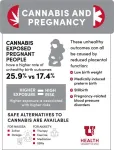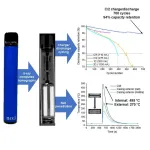(Press-News.org) WASHINGTON, DC, 2023, December 12, 2023 – The problem of foodborne metal contamination has taken on new urgency, thanks in part to a 2021 US Congressional Report detailing high levels of metals found in infant food pulled off grocery shelves. (More recently, high levels of lead were discovered in children’s fruit puree pouches.) Now, two new studies provide information on the correlation between exposure to heavy metals in food and the risk of cancers and other serious health risks. The findings will be presented at the 2023 Society for Risk Analysis Annual Conference.
Food crops can absorb heavy metals from contaminated soil, air, and water. As a result, traces of dangerous heavy metals – lead, arsenic, and cadmium – are found in common foods from rice and cereals to nuts and spinach. Felicia Wu, Michigan State University food scientist and incoming president of the SRA, is leading several investigations to gain a better understanding of the health risks of heavy metal exposure.
She will present the results of two recent studies at the December SRA meeting. The first is a comprehensive evaluation of the health risks associated with dietary exposure to lead, arsenic, and cadmium. The second is a quantitative assessment of the risk of cancer from inorganic arsenic exposure. “Results from these studies have important implications for food safety regulations, public health policies, and consumer awareness” says Wu.
Health risks of dietary exposure to lead, arsenic, and cadmium
In the first study, Wu, working with postdoctoral research fellow Charitha Gamlath and Ph.D. student Patricia Hsu, gathered data on the dietary intake of each metal from various sources such as food and water samples and existing studies and reports. The researchers analyzed the data to determine the strength of the association between dietary exposure and adverse health effects. Both cancer and non-cancer health effects were considered, and the strengths of the links between heavy metal exposure and each effect using Bradford Hill Criteria scores.
Lead is a toxic metal commonly found in old paint, water pipes, and contaminated soil. Food sources of lead include root vegetables like beets. In the study, lead showed moderate to high risk scores for causing lung, kidney, bladder, stomach, and brain cancers. It also showed moderate to high scores for non-cancer risks (hematopoietic, reproductive, neurological, renal, and respiratory effects).
Arsenic is a naturally occurring toxic element that can contaminate drinking water and food – especially in areas with high levels of arsenic in the soil. It can be found in rice, wheat, and leafy green vegetables, among other foods. Arsenic demonstrated moderate to high scores for skin, bladder, lung, kidney, and liver cancers. It also showed moderate to high scores for non-cancer risks (skin lesions, cardiovascular disease, immunological, neurological, reproductive, developmental, and renal effects).
Cadmium is a toxic metal found in nuts, potatoes, seeds, cereal grains, leafy green vegetables, and tobacco smoke. Among its sources in the environment are fertilizers and industrial emissions. In the study, cadmium revealed moderate to high risk scores for prostate, renal, bladder, breast, pancreatic, and endometrial cancers. It also showed moderate to high scores for non-cancer risks (renal, developmental, reproductive, immunological, and neurological effects).
Earlier this year, Wu co-authored a study on cadmium in baby food that was published in Food and Chemical Toxicology. In that paper, the researchers found that babies and young children 6 months to 5 years old are the most highly exposed to cadmium in common foodstuffs. American infants and young children of these age groups who regularly consumed rice, spinach, oats, barley, potatoes, and wheat had mean cadmium exposures exceeding the maximum tolerable intake level set by the Agency for Toxic Substances and Disease Registry (ATSDR).
Arsenic exposure and bladder, lung, and skin cancer cases in the U.S.
In the second study to be presented, Wu and Ph.D. student Rubait Rahman conducted a quantitative cancer risk assessment for different food products in the United States containing inorganic arsenic.
Their preliminary estimates suggest that every year, more than 6,000 additional cases of bladder and lung cancers and over 7,000 cases of skin cancers can be attributed to the consumption of inorganic arsenic in the United States. The researchers also found that certain food products can be associated with higher cancer risk than others. These include rice, wheat, and leafy green vegetables.
For this project, a comprehensive review of scientific literature was conducted to identify relevant studies on inorganic arsenic contamination in various food products and associated cancer risks. Data on arsenic levels in food products were obtained from regulatory agencies, such as the U.S. Food and Drug Administration (FDA) and the U.S. Department of Agriculture (USDA). Quantitative cancer risk assessment models were applied to estimate the cancer risk attributable to inorganic arsenic exposure through different food products. These models integrated exposure data, dose-response relationships, and population characteristics to quantify the probability of cancer occurrence.
###
Presentations are at the Westin Washington DC.
Assessing the Association between Dietary Exposure to Lead, Arsenic, and Cadmium and Adverse Health Effects: A Comprehensive Evaluation Using Bradford Hill Criteria- Tuesday, December 12, 10:45-11 a.m.
Cancer burden from dietary exposure to inorganic arsenic in the United States: Risk assessment and policy implications- Tuesday, December 12, 11:00-11:15 a.m.
About SRA
The Society for Risk Analysis is a multidisciplinary, interdisciplinary, scholarly, international society that provides an open forum for all those interested in risk analysis. SRA was established in 1980. Since 1982, it has continuously published Risk Analysis: An International Journal, the leading scholarly journal in the field. For more information, visit www.sra.org.
END
Heavy metals in our food are most dangerous for kids
2023-12-12
ELSE PRESS RELEASES FROM THIS DATE:
Artificial intelligence systems excel at imitation, but not innovation
2023-12-12
Artificial intelligence (AI) systems are often depicted as sentient agents poised to overshadow the human mind. But AI lacks the crucial human ability of innovation, researchers at the University of California, Berkeley have found.
While children and adults alike can solve problems by finding novel uses for everyday objects, AI systems often lack the ability to view tools in a new way, according to findings published according to findings published in Perspectives on Psychological Science, a journal of ...
MSK’s Omar Abdel-Wahab honored for research targeting blood cancers
2023-12-12
Physician-scientist Omar Abdel-Wahab, MD, is being honored at the 2023 American Society of Hematology (ASH) Annual Meeting with the William Dameshek Prize, which recognizes individuals who have made outstanding contributions to the field of hematology. The award will be presented December 12.
Dr. Abdel-Wahab, who chairs the Molecular Pharmacology Program at Memorial Sloan Kettering Cancer Center (MSK), was selected for his “trailblazing research” characterizing the genetic mutations that drive blood ...
Black individuals more likely to experience inequities in early diagnosis and treatment of Lyme disease, new research shows
2023-12-12
A new study out of the Johns Hopkins Medicine Lyme Disease Research Center has revealed disparities in the diagnosis and treatment of Lyme disease between Black and White patients with the condition. Researchers say the data, which draws on participants’ medical histories, whether from Johns Hopkins Medicine or other institutions, highlights issues in the nation’s medical education on Lyme disease.
In the full article, published December 12 in JAMA Network Open, researchers say that Black patients were more likely to have advanced stages of Lyme disease when clinically diagnosed and also experience a longer time before receiving antibiotic treatment for the condition.
Lyme ...
National Academy of Inventors honors SMU professor J.-C. Chiao as fellow
2023-12-12
DALLAS (SMU) J.-C. Chiao, the Mary and Richard Templeton Centennial Chair and professor in the Electrical and Computer Engineering Department in the SMU Lyle School of Engineering, has been named a fellow of the National Academy of Inventors (NAI).
Election as an NAI fellow is the highest professional distinction awarded to academic inventors. The NAI Fellows Program highlights academic inventors who have demonstrated a spirit of innovation in creating or facilitating outstanding inventions that have made a tangible impact on quality of life, economic development and the welfare of society.
Chiao, one of 162 inventors selected for the ...
Study paves way for development of advanced quantum networks
2023-12-12
The ability to transmit information coherently in the band of the electromagnetic spectrum from microwave to infrared is vitally important to the development of the advanced quantum networks used in computing and communications.
A study conducted by researchers at the State University of Campinas (UNICAMP) in Brazil, in collaboration with colleagues at ETH Zurich in Switzerland and TU Delft in the Netherlands, focused on the use of nanometric optomechanical cavities for this purpose. These nanoscale resonators promote interaction between high-frequency ...
Sanford Burnham Prebys elects Lori Moore to its Board of Trustees
2023-12-12
Sanford Burnham Prebys today announced that Lori Moore will join the Institute’s Board of Trustees.
“With many years in health care, both as a provider and a leader, Lori brings a welcomed depth and breadth of experience,” says David A. Brenner, president and CEO of Sanford Burnham Prebys. “Her perspectives will be much valued as the Institute advances its message of translating science into health.”
Moore is a registered nurse, a fifth-generation San Diegan and a member of the Cushman family, whose philanthropic endeavors span decades. She serves as vice president of The Cushman Foundation, which supports a wide range of community ...
New study explores ways to reduce inflammation and preserve bone health with prunes
2023-12-12
A new study published in The Journal of Nutrition shows daily consumption of prunes may reduce inflammation markers connected to bone signaling pathways and reduce the effects of bone loss among postmenopausal women.
“Bone loss is a significant issue impacting more than 50% of women over the age of 50, and there is no cure,” said Principal Investigator Mary Jane De Souza, PhD, Professor, Department of Kinesiology, Pennsylvania State University. “While medications and hormone therapies are available, they often require lifelong management and come with risks. It’s ...
Cannabis exposure linked to 1.5 times higher risk of unhealthy pregnancy outcomes
2023-12-12
SALT LAKE CITY - In the past ten years, the percentage of Americans who use medical marijuana has more than doubled as state-level legalization becomes increasingly common. But despite its prevalence as a medication, the full health effects of cannabis remain unknown, especially for specific populations—such as pregnant people—that might be especially at risk of health complications.
Now, in a large study of more than 9,000 pregnant people from across the U.S., researchers at University of Utah Health have found that cannabis ...
Single-use e-cigarettes contain batteries that last hundreds of cycles despite being discarded
2023-12-12
While the lithium-ion batteries in disposable electronic cigarettes are discarded after a single use, they can continue to perform at high capacity for hundreds of cycles, according to a study published December 12 in the journal Joule. The analysis, conducted by scientists from University College London (UCL) and the University of Oxford and supported by The Faraday Institution, highlights a growing environmental threat from these increasingly popular vape pens, which are not designed to be recharged.
“The surprise for us were the results that pointed toward just how long these batteries could potentially cycle,” says ...
Cannabis exposure and adverse pregnancy outcomes related to placental function
2023-12-12
About The Study: In a multicenter observational cohort, a composite adverse pregnancy outcome (small-for-gestational-age birth, medically indicated preterm birth, stillbirth, or hypertensive disorders of pregnancy) was more frequent in pregnant individuals with cannabis exposure ascertained by a urine drug assay compared with unexposed individuals. The risk for an adverse outcome was higher among those who continued to use cannabis beyond the first trimester.
Authors: Torri Metz, M.D., M.S., of University of Utah ...







